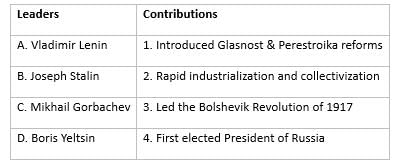UPSC Exam > UPSC Tests > Test: The End of Bipolarity- 2 - UPSC MCQ
Test: The End of Bipolarity- 2 - UPSC MCQ
Test Description
15 Questions MCQ Test - Test: The End of Bipolarity- 2
Test: The End of Bipolarity- 2 for UPSC 2025 is part of UPSC preparation. The Test: The End of Bipolarity- 2 questions and answers have been prepared
according to the UPSC exam syllabus.The Test: The End of Bipolarity- 2 MCQs are made for UPSC 2025 Exam.
Find important definitions, questions, notes, meanings, examples, exercises, MCQs and online tests for Test: The End of Bipolarity- 2 below.
Solutions of Test: The End of Bipolarity- 2 questions in English are available as part of our course for UPSC & Test: The End of Bipolarity- 2 solutions in
Hindi for UPSC course.
Download more important topics, notes, lectures and mock test series for UPSC Exam by signing up for free. Attempt Test: The End of Bipolarity- 2 | 15 questions in 20 minutes | Mock test for UPSC preparation | Free important questions MCQ to study for UPSC Exam | Download free PDF with solutions
Test: The End of Bipolarity- 2 - Question 1
When did the socialist revolution take place in Russia?
Detailed Solution for Test: The End of Bipolarity- 2 - Question 1
Detailed Solution for Test: The End of Bipolarity- 2 - Question 2
Test: The End of Bipolarity- 2 - Question 3
Who controlled the east European countries after the second world war?
Detailed Solution for Test: The End of Bipolarity- 2 - Question 3
Test: The End of Bipolarity- 2 - Question 4
What was the name of the military alliance that held the east European countries together?
Detailed Solution for Test: The End of Bipolarity- 2 - Question 4
Test: The End of Bipolarity- 2 - Question 5
Who was the general secretary of the communist party of the soviet union in 1985?
Detailed Solution for Test: The End of Bipolarity- 2 - Question 5
Test: The End of Bipolarity- 2 - Question 6
Who emerged as a national hero in opposing the coup?
Detailed Solution for Test: The End of Bipolarity- 2 - Question 6
Test: The End of Bipolarity- 2 - Question 7
When did Yeltsin, Russia, Ukraine, and Belarus declare that the soviet union was disbanded?
Detailed Solution for Test: The End of Bipolarity- 2 - Question 7
Test: The End of Bipolarity- 2 - Question 8
Why did the Soviet economy stagnate in the late 1970s
Detailed Solution for Test: The End of Bipolarity- 2 - Question 8
Test: The End of Bipolarity- 2 - Question 9
Which of the following statements about the Soviet political system is incorrect
Detailed Solution for Test: The End of Bipolarity- 2 - Question 9
Test: The End of Bipolarity- 2 - Question 10
Who took over as the only nuclear state of the post-soviet space?
Detailed Solution for Test: The End of Bipolarity- 2 - Question 10
Test: The End of Bipolarity- 2 - Question 11
Shock therapy involved a drastic change in the ...................... orientation of the economies.
Detailed Solution for Test: The End of Bipolarity- 2 - Question 11
Test: The End of Bipolarity- 2 - Question 12
Which party had ruled the soviet union for over 70 years?
Detailed Solution for Test: The End of Bipolarity- 2 - Question 12
Test: The End of Bipolarity- 2 - Question 13
Who promised to reform the economy, catch up with the west, and loosen the administrative system?
Detailed Solution for Test: The End of Bipolarity- 2 - Question 13
Detailed Solution for Test: The End of Bipolarity- 2 - Question 14
Test: The End of Bipolarity- 2 - Question 15
Match the leaders of the Soviet Union with their contributions:

Detailed Solution for Test: The End of Bipolarity- 2 - Question 15
Information about Test: The End of Bipolarity- 2 Page
In this test you can find the Exam questions for Test: The End of Bipolarity- 2 solved & explained in the simplest way possible.
Besides giving Questions and answers for Test: The End of Bipolarity- 2, EduRev gives you an ample number of Online tests for practice
Download as PDF




















